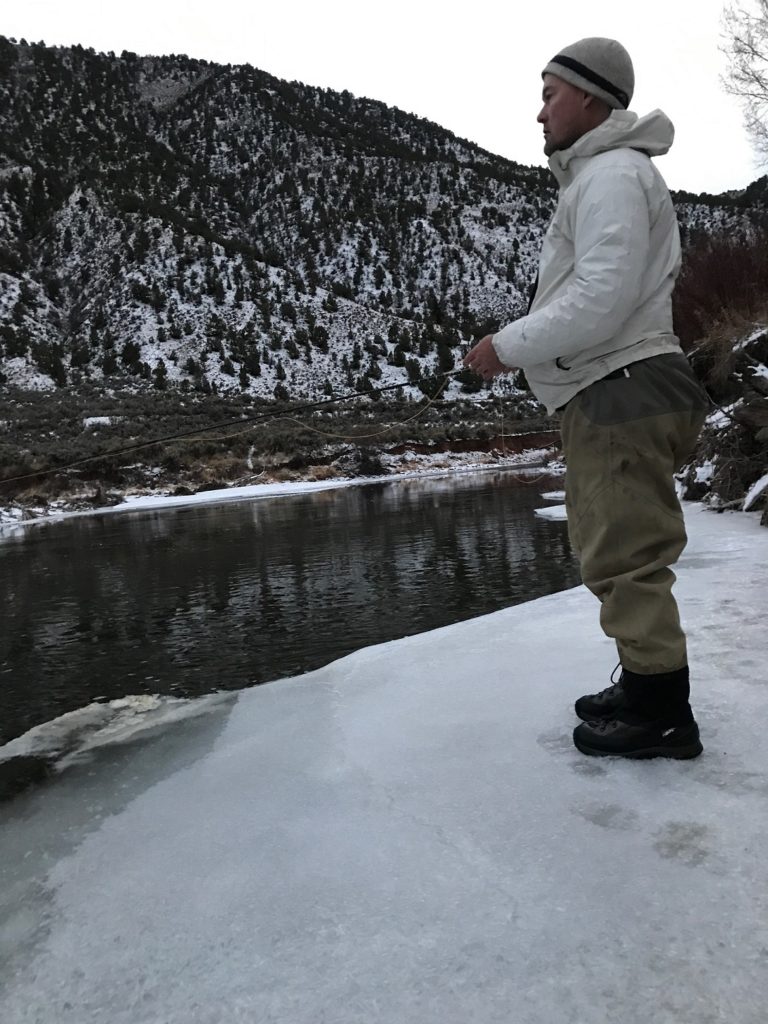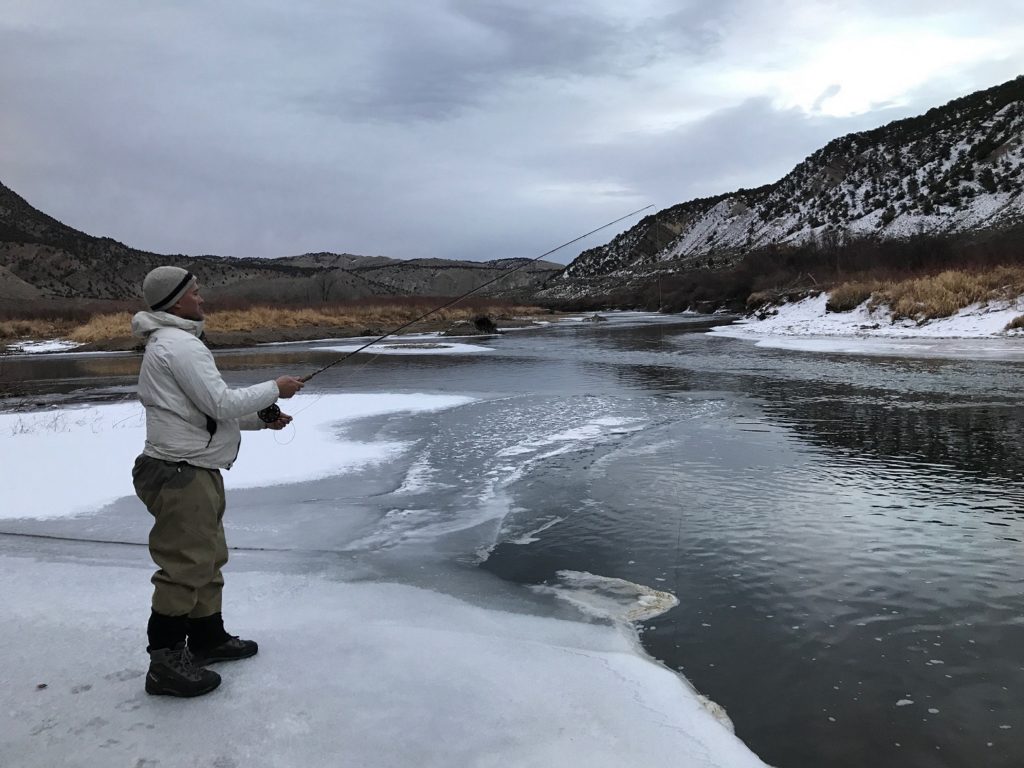One of the benefits of living in the Colorado Rocky Mountains during the winter is the close proximity to a long list of world-class ski resorts. Another common factor found in most Colorado ski towns is water. The majority of ski towns need water, which in its frozen state attracts people to the ski areas. There’s usually a stream or river located in the valley of most ski mountains. Those watersheds provide the basis for snow making in the resorts. And for the knowledgeable tourist and traveling angler, the streams running through ski towns become attractants themselves for adventurous individuals looking to double dip during their ski vacation with a day spent cruising the groomed runs in the early morning and wading through winter runoff with a fly rod in the afternoon.
During lean snow years, snow sports participants long for deep powder days while exploiting the manicured trails snowcats provide. Groomed ski runs created overnight by the snowcat crews create a deep burn in most legs. Powder days, well, we don’t leave the mountain on powder days! However, skiers and snowboarders alike often need a break from the strenuous activity by midday, a perfect starting time for wading into the open water of the local streams and tempting a trout or two into your net.

Common misconceptions.
Travelers have a misconception regarding winter fly fishing and seasonal closures in many other states prevents wintertime angling. Here in the mountains of Colorado, we have the fortunate opportunity to angle for trout twelve months a year. Tailwaters located below dams remain open and ice free most of the winter months. Freestone streams will have open areas depending on exposure to sunlight and during any warm weather periods. Knowledgeable winter fly fishing guides have their finger on the pulse of a river at all times and can put an angler on productive water throughout the winter months.

The ski tourist comes prepared for winter conditions and extreme weather when arriving in any ski town. The same gear for skiing doubles as excellent winter fly fishing layers. Worn under waterproof waders, ski clothing does all the right things for anglers as well – move sweat away from the body, insulate the core from cold and block temperature-stealing winds.
Socks, a specialized accessory in the ski industry, possess the necessary features to perform under demanding conditions. With arch supporting elastics and combinations of materials to keep feet from feeling clammy, ski socks work great under a pair of waders and wading boots. Unlike ski boots which you want as tight as skin, wearing the next whole size up from your normal size gives wading anglers the room for thicker than normal ski socks. Larger boots also allow the use of toe heaters without feeling cramped.

Timing your approach.
As far as timing goes, the midday sun has had enough time to work its magic on the water and anywhere it can penetrate the surface to warm deeper currents causing an emergence of midges. Midges are a food source that trout exploit twelve months a year. Midges are often the only bug activity happening in the midst of winter. Targeting trout with the earliest stages of the midge life cycle, the larva and pupae stages, can work wonders for wintertime fly anglers.
Overcast days during the winter are not to be shunned. A gray flat light day can be a task to endure for skiers with little shadowing to define undulations in terrain. But for the winter bound fly fisher, gray days signal an emergence of Blue Wing Olives in tiny sizes, #18-22. Tempting trout to the surface to eat a dry fly in the middle of winter is possible. A dry-dropper rig can cover the top few feet of the water column efficiently and effectively. Use the dry fly for an indication of a subsurface eat, as most strikes will come on the nymph or emerger.

Flies for the cold.
For wintertime flies, a selection of midge larva such as the beadhead zebra midge in a variety of colors such as black, olive and red are good choices. Tiny RS-2 patterns in black or gray, a personal favorite, can entice numerous bites during the colder months of the year. Small soft hackles in sizes 18 and 20 breathe as they drift through the water. The added subtle movement of soft hackle flies can sell the presentation guaranteeing a strike in cold weather. And for dry flies the familiar Parachute Adams in sizes 16-20 can be fished with confidence the entire winter season both as an indicator fly and as the primary offering when noses begin to poke through the surface.
Choosing your gear.
Wintertime fly fishing does not call for your best handmade bamboo rod. Gear needs to withstand harsh conditions like frozen guides, ice glazed lines and slippery riverside rocks. The Echo Carbon XL 9’ 5wt is a perfect stick for the cold. The 9’ length allows for more better line control and enhanced feel as you guide your flies down the river. Paired up with an Airflo Elite fly line and a 9′ Sightfree 5X leader and tippet and you can’t go wrong.
The added durability you gain from the Airflo Sightfree fluorocarbon leaders and tippets ensure success throughout a long tenuous fishing day. The repeated dragging of flies across frozen rocks and over ice shelves weakens knots and compromises the strength of your leader. Taking the time to retie your flies in the winter can be a frustrating event given cold fingertips, but the added attention to your terminal gear will payoff when a 20” winter-bound brown trout eats your fly.

Double dipping in the Colorado ski-mountains is an easy affair to execute with skiing in the morning and fly fishing in the afternoon. The underlying clothing can serve perfectly well for both purposes. Fly selection for wintertime is very specific and angling can be achieved with a small variety of flies. Minimal terminal gear is necessary and local fly shops offer guided trips throughout the year as well as providing rental rods and waders if you want to venture out on your own. So take a page out of the local’s book and treat yourself to a wintertime Double Dip.
~ Michael Salomone is an Echo & Airflo Ambassador, Vail Valley Anglers Guide & Content Writer. You can contact him through his website: www.MichaelSalomone.com or by calling Vail Valley Anglers at 970-926-0900.

Recent Comments